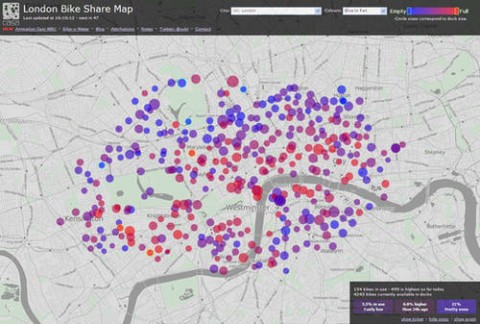
A leading transport economist has suggested that slower-than-expected growth of the Barclays Cycle Hire scheme is due to riders' fear of sharing London's streets with motor traffic rather than flaws in the project's infrastructure.
"There's never been a shortage of bikes in London," Professor Stephen Glaister of Imperial College, London told The Economist. "It's just that people are afraid to use them."
The city's bike hire scheme was launched in July, with the goal of 50,000 journeys per day. Surveys carried out during the first six months of the scheme have indicated peak usage climbing to around 26,000 trips.
The significant level of surplus capacity available within the system appears to back up Professor Glaister's suggestion, with The Economist proposing that bike paths like those found in countries such as Belgium and the Netherlands, which separate cyclists from other traffic, may be needed before the majority of Londoners will be convinced to use the bikes.
The success of the two pilot Cycle Superhighways suggests that many residents are prepared to consider cycling to work or for leisure, as long as it's made safe and easy for them.
With London's hire scheme still in its relative infancy, Transport for London (TfL) told BikeRadar that they expect usage figures to increase during the programme's first full summer of operation this year. "Numbers are naturally higher during summer. The colder, darker months are always going to reduce the volume of users," said TfL senior press officer Jenna Oxley. Figures are also likely to be boosted by the introduction of a casual user system last month.
Take-up of the Barclays hire bikes hasn't been helped by continuing teething problems. In particular, concerns have been raised over the distribution of bikes across the network of 315 docking stations. The Economist pointed out that "after-rail" users - those using bikes to travel from train stations to their final destination - were creating a dearth of bikes at certain docking stations; an issue which had been acknowledged in a 2008 feasibility study.
The stress placed on the system around major stations such as Waterloo, Euston and Kings Cross at peak times is visible in a unique live mapping system operated by the Centre for Advanced Spatial Analysis (CASA) at University College, London. Visitors to their website can see which stations are most popular and how many bikes are still available. Click on the image below to visit the site.
By Richard Tyler, in London, England
http://www.bikeradar.com/news/article/londoners-afraid-to-use-barclays-h...
